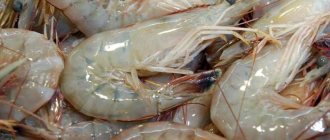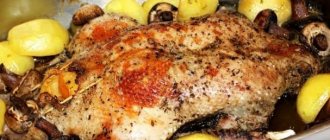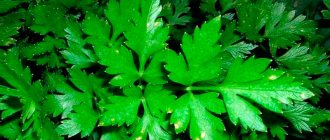It's time to love fiber
All of us, who spent decades eating mainly refined foods, became imbued with the ideas of healthy eating and understood the importance of saturating our diet with fiber.
How can you not understand?! Why do residents of Chukotka and the Far North have such a short average life expectancy of 39-40 years?
Because the main product on their table is only venison in various forms and a complete lack of fiber, which sooner or later leads to big problems with the intestines and the entire body.
Therefore, for you and me, who live in more favorable conditions, where you only have to bend down and pick it up from the ground for fiber, it is unforgivable to neglect your health.
Where is it, this indigestible fiber valuable for the intestines? The question is rather rhetorical, because it is everywhere, but somewhere more, somewhere less.
How much should you eat per day?
For normal functioning of the body, it is recommended to consume 30-50 grams of fiber daily, depending on the person’s weight. This means that every day you need to eat about 3 medium fruits and 3 medium vegetables. You also need to eat 4 servings of wholemeal bread or bread with bran. In addition, it is necessary to consume legume products several times a week, because... they are also very rich in fiber.
Of course, in the rhythm of a big city and work schedule, it is difficult to take so many breaks for lunch, so scientists have developed a dry product for our convenience that can be easily added to food.
Introduce fiber with caution
If you heard the word fiber (cellulose) for the first time, and, with the best intentions, decided to dramatically change your diet, then beware - the body must get used to coarse plant fibers gradually , otherwise the intestines will not cope and the crown of all good intentions will be atony.
The body should be accustomed to fiber according to the principle of supplementary feeding for infants - first, the mother saturates it with breast milk, and when there is not enough of it, they give a little porridge.
It should be the same for adults: we add unfamiliar cellulose to the main and usual contents of food - fats, proteins, carbohydrates, vitamins.
Fiber: 3 Facts with Proof Why It's Actually Hazardous to Your Health
Thanks to this, the feeling of fullness lasts for a long time. Another benefit of oat fiber is increased intestinal motility, which reduces the absorption of food eaten.
Recently, it has become important to take not only plant fibers from natural products with food, but also to use specially developed fiber in tablets in the fight against excess weight. You can buy this product at a pharmacy. Microcellulose Evalar MCC is considered one of the well-proven products.
You can find such fiber both in granules and tablets, and in powder. This dietary supplement helps fight obesity, lowers cholesterol and minimizes the body's toxins. As for choosing the type of fiber, you need to base it on your needs and the desired result. As noted above, fiber can be of two types, and accordingly its actions differ.
Fiber can be called a unique product containing a lot of plant fibers. It promotes weight loss by removing extra pounds. Diets containing fiber are quite effective. It is necessary to accustom the stomach to plant fibers gradually, since nutritionists note negative consequences of a sudden transition to a diet with a high fiber content.
If you use dry fiber powder, then the diet should look like this: The daily intake of products is given, it is divided into 4 doses and with each of them use 2 tsp of fiber powder. You should not sit on such a minimal diet for a long time; starting for up to 5 days on such a diet is quite enough.
If you use fiber in tablets when losing weight, then the diet changes significantly and has the following form: With this diet, fiber tablets are washed down with plenty of water.
You will find a table for creating a diet below. To prepare the drink, you need to dilute 4 teaspoons of fiber in a liter of kefir. Drink the composition in 4 doses.
On the day you want to use the kefir mixture, do not eat anything else; you are allowed to drink clean water. Such fasting days can be carried out twice every 7-10 days with active weight loss. Here's what women write about fiber for weight loss: And here are photo reports of girls using fiber for weight loss.
The basis of dietary nutrition for weight loss is the intake of plant fibers, and it does not matter whether it is a pharmaceutical option or a food option. An approximate menu for someone losing weight who uses fiber as the main element in the fight against extra pounds should look like this:
How to take fiber for weight loss?
You should not forget about the drinking regime, since it is the basis for the proper functioning of the body, no matter what diet you choose. Fiber is the rough part of natural plants, namely the peel and shell of products.
Fiber can either enter the body through simple foods or be taken in the form of special medications sold at pharmacies. Fiber itself is a carbohydrate that is not absorbed by our body.
In other words, the stomach is full and the feeling of satiety is present, but no calories are supplied or absorbed. The main types of plant fiber include:.
Wheat fiber for weight loss. It is rich in cellulose and hemicellulose. These elements can be found in bran, green peas, legumes, beets, carrots, bell peppers, and apples. Consuming these products or their concentrate from the pharmacy along with sufficient fluids helps the colon function. It is pointless to argue about the best type of fiber, since it copes equally well with the task of cleansing the body by detoxifying, regardless of the form of release.
According to doctors, from a physiological point of view, fiber can really get rid of excess weight. Flax seeds do not allow food to stagnate, speeding up digestion and metabolic processes, which is important for those losing weight. Plant fibers prevent spasms and constipation, prevent hemorrhoids, pathological diseases and even oncology.
The chemical composition includes mucous substances that saturate the body for a long time. The seeds can be taken in a variety of ways:. To get the maximum benefit when losing weight, flaxseed must first be soaked in kefir: dissolve 80 g of powder in 4 glasses of low-fat kefir, consume during the day with an interval of 4 hours. Frequency: once a week. Steamed flax seeds will help avoid unwanted gas formation: 1 teaspoon of powder is poured into a glass of boiling water, leave for 30 minutes.
Take ml a day half an hour before meals. Flaxseeds complement cereals, smoothies, desserts and other dishes. The main thing is not to forget about drinking plenty of fluids and then the supplement will help stabilize your weight. The composition includes a mixture of dietary fiber, cereals and fruits, so Siberian fiber is useful for the body in terms of weight loss and enriches it with important microelements. Manufacturers can use a rye or wheat base in the form of bran, nuts, berries and fruits.
Fruit-cereal mix helps in weight loss:. Siberian fiber can be consumed in unlimited quantities until the feeling of hunger is eliminated, but after consulting a doctor.
It is recommended to dilute with freshly squeezed juice, fermented milk products or any other liquid: 2 tablespoons of the component per ml. Dietary fiber absorbs toxic substances and beneficial elements, so it is recommended to simultaneously consume a vitamin complex.
Milk thistle cake is used to restore the functioning of the liver and gall bladder. It is useful for weight loss due to its properties of accelerating metabolism. The absorbent effect prevents intoxication of the body.
Directions for use: tablespoons twice a day, 40 minutes before meals, with liquid to taste. Oat bran fiber contains 12 amino acids, omega-3 and omega-6 fatty acids, and vegetable protein. Helps remove toxins from the body, prevent constipation, improves liver and gallbladder function.
Bran is slowly digested, dulling the feeling of hunger. Directions for use: 2 times a day before meals, 2 tablespoons, dissolved in advance in a glass of liquid. Pour a glass of boiling water over the pumpkin seed cake and let it brew. The swollen mass can be added to dishes. For those who do not like foods with fiber and do not accept the presence of coarse plant fibers in their diet, pharmacists have made tablets. When they enter the stomach, they swell, dulling hunger. The functions of the drug are identical to the herbal components, the advantage is compactness and ease of storage, precise dosage.
Directions for use: the daily dose and dosage are indicated on the packaging of the drug, the main condition is to drink with a large volume of water. It is recommended to give preference to natural foods, and use pharmaceutical products if it is not possible to eat bran, fruits or vegetables, legumes and other products.
The best source of fiber is from unprocessed plant foods, as they provide all the essential minerals and nutrients. If you consume enough fiber-rich foods, there is no need to take dietary fiber supplements.
The table below contains a small list of the most popular products for the daily menu. On a diet during the period of consuming fiber, there is an active loss of extra pounds. Fiber is added to main dishes, drinks, desserts and baked goods.
What is fiber
Method for preparing the drink: 1 liter of low-fat kefir is mixed with fiber for 4 hours. Consume 4 times a day. The swelling of plant fibers saturates the body, so you can lose weight with fiber without a systematic feeling of hunger.
The body is accustomed to a natural or pharmaceutical product gradually. First of all, you need to correctly calculate the daily calorie requirement at the weight loss stage, and then create a detailed menu. Variant of the fiber intake regimen: serving - 1.5 tablespoons:. Doctors support the inclusion of fiber in the menu of overweight people due to its beneficial properties from a physiological point of view, but in addition to this, monitor your diet, do not overeat and give preference to healthy foods.
The intestines love fiber only at night, not during the day
To make it clearer when it is more appropriate to feed the body with fiber, let’s look at the work of the intestines.
The organ that works at full capacity is the one that does not experience problems with blood supply, that is, the law of blood flow applies - what works is what is supplied with blood.
During the day we move intensively, therefore, more blood flow rushes to the working organs, and blood flows to the intestines according to the residual principle.
Therefore, it is not very wise to load the intestines with heavy work in the form of indigestible fiber during the day.
There is a good chance that the food conveyor will stall, unable to cope with the cellulose load, and we will become constipated.
When is it more profitable to throw fiber to the intestinal microflora? The answer is obvious - at night!
When going to bed, when we take a horizontal position, a certain environment is created that promotes peace and relaxation - watch the news, drink some tea, take a nap.
At the same time, our smart body is already adjusted to the fact that we are about to switch off and the working muscles will no longer need to be supplied with blood, only the brain, at a minimum, so that we can watch dreams.
All organs that worked intensively during the day rest. And the intestines, which sluggishly let easily digestible food pass through themselves, can be forced to work on something more serious, since all the released resources of the body, all the blood goes to the intestines at night.
That's why he grumbles the most at night, which is very correct.
And it is precisely this active state of his that must be turned to his advantage and forced to work on coarse fiber.
Sample menu with fiber
There are many diets for weight loss based on dietary fiber. Let's look at one with an energy value of 1300 calories. It is important to note that you need to drink about 2 liters of water per day. Before each meal, it is recommended to eat a salad of raw vegetables: celery, lettuce, cucumbers, peppers, tomatoes and others. You can top it with a spoonful of yogurt or lemon juice.
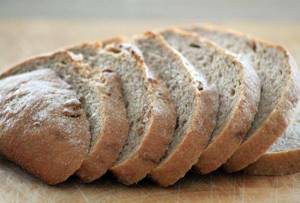
Breakfast (alternate options)
- A piece of whole wheat bread with butter, grapes, 1 apple, 1 banana.
- Two slices of rye bread, banana, 1 tsp. honey
- Two wheat toasts, a glass of low-fat milk or orange juice, an apple.
Dinner
200g boiled potatoes with the following products to choose from:
- Finely chopped cabbage.
- 100g cheese.
- Lean ham or boiled chicken breast – 50g
- 2-3 tbsp. boiled beans.
Dinner
100g pasta with your choice of the following:
- Shrimp cooked with garlic and tomatoes.
- 2-3 tbsp. stewed mushrooms, boiled chicken.
- 50g lean ham with garlic and tomatoes.
- 200g fried fish.
- 125g boiled potatoes.
- Any vegetable salad.
- Apples or bananas.
If you feel discomfort during the weight loss period, consult a doctor or stop following the diet.
Proteins and carbohydrates - as a supplement to fiber
So, there is no doubt - the ideal late dinner, consisting of cellulose, should be taken half an hour before a 10-hour sleep.
It is 10 hours of sleep that is recommended so that the intestinal microflora has time to work with indigestible fiber for a long time and thoroughly, while gently emptying the gallbladder.
Therefore, to frequently asked questions like “Can I have cottage cheese or eggs at night,” the answer will be: “Yes, you can, but it will be better for health if the predominant component of a late dinner is not proteins, but coarse fiber.”
Let your usual eggs, cottage cheese and kefir set the body to a state of eubiosis, so that falling asleep is quick and pleasant, and the main work, which the intestines will provide with coarse fiber, will begin a little later and will continue until the morning.
Dietary fiber norm
Increasing fiber in your diet for weight loss should be accompanied by drinking plenty of water.
Every day you need to consume:
- 1.5-8 years – 19 years
- 9-13 years old – 26g for girls and 31g for boys.
- 14-19 years old – 26g for girls and 38g for boys
- Up to 50 years - 25g for women (during pregnancy and lactation 29g) and 35-40g for men.
- After 50 years – 21g for women and 30g for men.
Unfortunately, most people consume only a fraction of this amount. Fiber deficiency can lead to serious negative health effects. But increasing the amount of dietary fiber in your diet is not at all difficult, just get the information and be consistent. It is especially important to include fiber in the menu when eating protein foods.
To avoid dietary fiber deficiency, they can be consumed in the form of a special powder that is easily digestible. It can be added to various drinks, baked goods or washed down with water. You need to adhere to the recommended doses to avoid problems with the gastrointestinal tract.
In the morning - the result
And in the morning, the rectum, clogged with waste material, will be ready for emptying.
And again the redistribution of blood flow from the empty intestines to the organs that work during the day will be repeated.
The intestines have fulfilled their main duty - they have thrown out a lot of toxins from the body with the help of fiber, freed themselves up for a new supply of food, and in the meantime, they can rest during the day.
Therefore, a eubiotic correct dinner means not only normal intestinal microflora and successful morning bowel movements, but also the absence of venous stagnation, intestinal problems, hemorrhoids and rest of all body systems.
Fiber diet rules
This diet is based on two main principles:
- Reduce the number of calories you consume.
- Increase your intake of fiber-rich foods.
Use nuts, dried fruits, fresh berries and fruits as a snack. Drink enough clean, still water. Give preference to freshly squeezed juices, compotes, smoothies, herbal teas rather than sweet soda. Season salads with yogurt and vegetable oil. Instead of frying, stew, boil, bake, steam.
Other diet rules:
- Vegetable oil should be present in the diet every day (you can take, for example, flaxseed oil during the diet);
- the best breakfast is porridge with water;
- Priority is given to dairy products without additives and flavorings.
The diet can be followed for no more than one month. To avoid problems with digestion, you can repeat it only once every six months.
For those who are not prepared to adhere to strict dietary restrictions, it is recommended that you at least include more fiber-containing foods in your daily menu. This option will also contribute to weight loss and cleansing of the body.
What does cellulose contain?
- The champion in fiber content is turnip. It is recommended to steam it over low heat for 8-12 hours.
- In second place are fibrous root vegetables (rhubarb, radish, fodder beet, Jerusalem artichoke) and mushrooms
- Next, dark grains deserve attention - oats, millet, buckwheat, barley
- All again fibrous vegetables and fruits
- Bran, wholemeal bread
All these foods rich in fiber (cellulose) should be introduced into the diet as a eubiotic (late) dinner gradually, starting with a spoon, and over 6-8 months increasing the portion to the size of the plate.
Fiber for weight loss
Those who want to lose weight should love fiber. Fiber is dietary fiber found in vegetables, fruit skins and grain hulls. It is not absorbed by the body, but brings invaluable benefits to it, and also helps control appetite and helps to quickly lose excess weight.

Types of fiber
Fiber can be functional or plant-based. You've probably seen functional fiber on store shelves and pharmacies in the form of supplements. Plant foods are hidden from our eyes, but they play a special role in proper nutrition.
Plant fibers, or fiber, are very useful for normal intestinal function. They come in two types: soluble and insoluble. The first ones turn into liquid, swell and become jelly-like. Such an environment has a beneficial effect on the development of beneficial bacteria (calorizer). Soluble fiber can combat hunger and is found in fruits, barley, oats, seaweed and legumes.
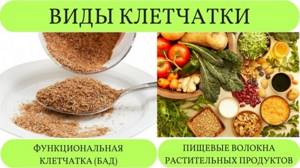
Insoluble fiber is also beneficial for the digestive system. They flush out cholesterol and bile acids. There is a lot of such fiber in grain crops, as well as in vegetables and fruits.
If you eat few vegetables and fruits, you can cause problems with the digestive system. Fiber is also recommended not only for the treatment of foodborne diseases, but also for their prevention. Fiber prevents cancer of the colon and small intestine, and the occurrence of gallstones.

Fiber and weight loss
Nutritionists have proven that consuming fiber has a beneficial effect not only on health, but also on weight loss. The whole secret is that plant fiber helps reduce fat deposits. Fiber is recommended even for patients with diabetes, because it lowers blood sugar levels. It can be consumed both with fresh vegetables, fruits, legumes, etc., and in the form of a dietary supplement.
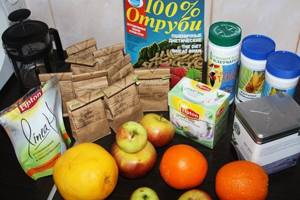
According to scientists from Examine, dietary fiber helps control appetite and keeps you feeling full for a long time. It's all about the mechanoreceptors of the gastrointestinal tract, which suppress appetite. They are activated not by hormones, but by stretching of the stomach tissue. That is, when you eat a large amount of food, you activate receptors that help you feel full longer and not bite. Fiber-rich, non-starchy vegetables are the best way to bulk up your meals without going overboard on calories.
Nutritionists advise eating a serving of non-starchy vegetables first to fill your stomach and increase your chances of not overindulging in high-calorie foods. Dietary fiber slows down the rate of digestion, which not only promotes satiety, but also reduces the glycemic index of foods. Therefore, overweight people are advised to eat at least 3 servings of vegetables per day.
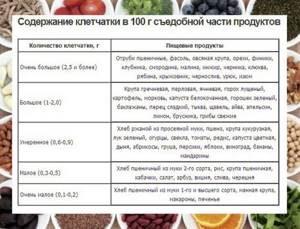
How much fiber should you eat?
In order to lose weight and not harm your health, it is enough to start your day with buckwheat porridge, muesli, a green apple or a glass of orange juice.
The daily fiber requirement for weight loss is 25-40 grams. For every thousand calories in your diet, you should get 10-15 grams. If you eat 1500 calories, you need to get at least 15 grams of fiber, and most people today don't eat 10 grams.
To give you a little guidance, here's how much fiber is found in the most common foods. A slice of white bread contains 0.5 g of fiber, rye bread – 1 gram, bran bread – 1.5 grams. A cup of white rice - 1.5 grams, lettuce - 2.4 grams, carrots - 2.4 grams, 1 orange - 2 grams.

It’s not easy to reach your daily requirement solely from plant foods, especially since cereals, fruits and starchy vegetables can easily go beyond the daily calorie limit (calorizator). In addition, heat treatment and grinding of foods destroy dietary fiber. For example, in 100 g of potatoes there is about 2 g of fiber, but after boiling there is nothing left in the peeled form.
Therefore, nutritionists advise minimally processed foods, avoiding juices in favor of fruits, and consuming fiber as a supplement by adding it to porridge, diet baked goods, and dairy products. And to increase the effect of fiber, drink it with plenty of water. It will absorb water and increase in volume, which will activate the gastrointestinal tract receptors and ensure satiety.
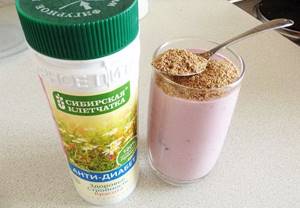
You need to add fiber to your daily diet gradually. Failure to adhere to this recommendation may result in stomach upset, increased gas production, and diarrhea.
Fiber is a valuable complex carbohydrate that not only helps control appetite and lose weight comfortably, but also has a beneficial effect on the gastrointestinal tract, lowers cholesterol and maintains blood sugar levels.
Author: Jannette (specially for) Copying of this article in whole or in part is prohibited.
How to use pharmaceutical fiber?
On pharmacy shelves you can find pure fiber in powder form, as well as with various supplements that promote greater health. Whatever product you choose, you need to follow some recommendations:
- It is necessary to start a course of taking plant fibers with 0.5 tbsp. l. per day, gradually (over 2 weeks) increasing the dosage to 2 tbsp. l.
- To avoid negative consequences from consuming fiber (flatulence, pain), the daily portion is divided into several small parts.
- Take fiber 30 minutes before meals.
- Drink more fluids between meals, as fiber can cause constipation.
Fiber is dissolved in water, but this option is very simple and not everyone will like it. Prepare a delicious, healthy smoothie, the basis of which can be berries, fruits, juices, kefir or natural yogurt. In addition, the powder can be added to soups, main courses and even snacks.
Fiber is contraindicated for people with acute stomach diseases: ulcers, gastritis, duodenitis, etc.









